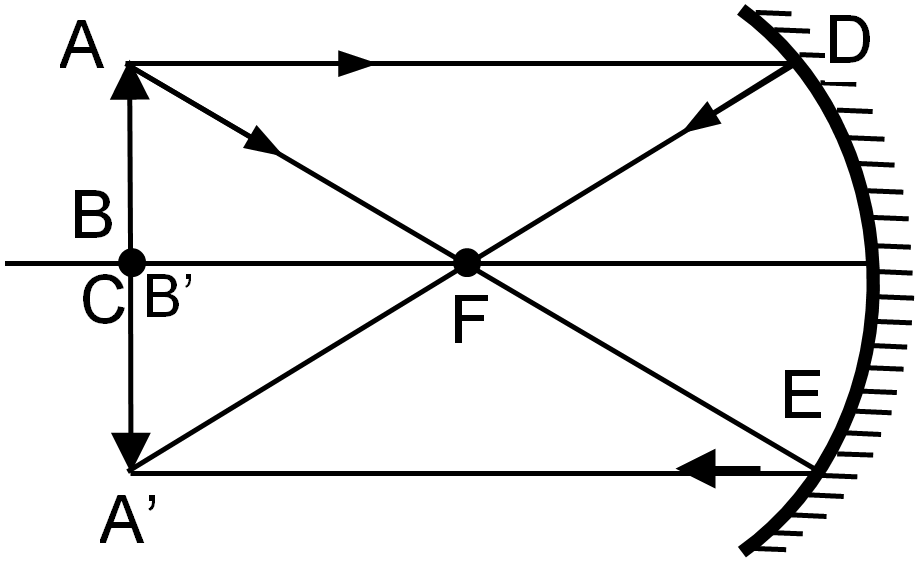Different types of images can be formed by a concave mirror by changing the position of the object from the concave mirror. Therefore different types of images are formed when the object is placed
1. At the infinity
2. Beyond the centre of curvature
3. At the centre of curvature
4. Between centre of curvature and principal focus
5. At the principal focus
6. Between the principal focus and pole
1. Image formed by a concave mirror when the object is placed at infinity
When the object is placed at infinity, the two rays AB and DE running parallel to the principal axis get reflected at point B and E respectively and intersect each other at the principal focus F on the principal axis. Therefore, in this case the image is formed at the principal focus which is highly diminished, real and inverted.

2. When the object is placed beyond the centre of curvature
When the object AB is placed beyond the centre of curvature then a ray of light AD which is parallel to the principal axis and another ray AE which pass through the centre of curvature intersect each other after reflection at point A’ between the focus and centre of curvature. Thus the image formed is between the principal focus F and centre of curvature C, diminished, real and inverted.

3. When the object is placed at the centre of curvature
When the object AB is placed at the centre of curvature C, then a ray of light AD which is parallel to the principal axis and another ray AE which pass through the principal focus intersect each other after reflection at point A’ just below the position of the object. Thus the image formed in this case is at the centre of curvature, of same size as the object, real and inverted.

4. When the object is placed between the centre of curvature and principal focus
When the object AB is placed between the centre of curvature and principal focus, then the ray AD running parallel to the principal axis and another ray AE passing through the principal focus F intersect each other at point A’ beyond the centre of curvature. Thus the image formed in this case is beyond C, enlarged, real and inverted.

5. When the object is placed at principal focus
When the object AB is placed at the principal focus, then the parallel ray of light AD passes through the principal focus F giving us the reflected ray DX. And the second ray of light AE passing through the centre of curvature C is reflected along the same path forming the reflected ray EY. In this case, both the reflected rays i.e. DX and EY become parallel to each other so these rays cannot intersect each other and the image will be formed at infinity. The image formed in this case will be highly enlarged, real and inverted.

6. When the object is placed between the principal focus and the pole
When the object AB is placed between the principal focus and the pole, then the parallel ray of light AD passes through the focus F giving us the reflected ray DX. And the second ray AE passing through the centre of curvature C is reflected along the same path forming the reflected ray EY.

Now, because the reflected ray DX and EY are diverging away from each other, so these cannot intersect each other in front of the mirror. So, the reflected rays DX and EY are extended backward by dotted lines. On extending backwards, these rays appear to intersect each other at point A’ behind the mirror. Thus the image formed in this case is behind the mirror, highly enlarged, virtual and erect.
Table: Summary of images formed by a concave mirror
| S No. | Position of Object | Position of Image | Size of Image | Nature of Image |
| 1. | At infinity | At the focus F | Highly diminished | Real and inverted |
| 2. | Beyond the centre of curvature C | Between F and C | Diminished | Real and inverted |
| 3. | At the centre of curvature C | At C | Same size | Real and inverted |
| 4. | Between C and F | Beyond C | Enlarged | Real and inverted |
| 5. | At focus F | At infinity | Highly enlarged | Real and inverted |
Test Your Understanding and Answer These Questions:
- Explain formation of different types of images by a concave mirror with the help of diagrams.
- Where an object should be placed in front of the concave mirror so as to obtain a real image equal to the size of the object?
